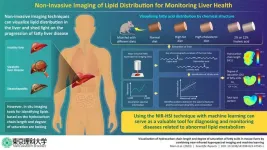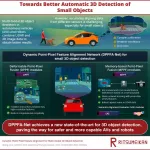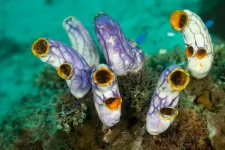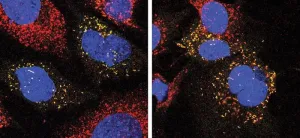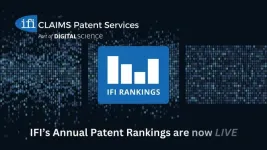(Press-News.org)
Steatotic liver disease (SLD), previously known as non-alcoholic fatty liver disease, which includes a range of conditions caused by fat build-up in the liver due to abnormal lipid metabolism, affects about 25% of the population worldwide, making it the most common liver disorder. Often referred to as “silent liver disease,” SLD progresses without noticeable symptoms and can lead to more severe conditions like cirrhosis (liver scarring) and liver cancer.
A liver biopsy—an invasive procedure involving liver tissue sample extraction from the body—is the conventional method of testing for SLD. To simplify detection, a research team led by Professor Kohei Soga of Tokyo University of Science (TUS) had previously introduced near-infrared hyperspectral imaging (NIR-HSI) as a non-invasive method to visualize the total lipid content in the liver. NIR light, with longer wavelengths (800–2500 nm) than ultraviolet and visible light shows absorption attributed to various organic substances, including biomolecules in tissues, enabling the identification of fat distribution in the liver.
Now, in a new study published in the journal Scientific Reports on 23 November 2023, the research team, including Prof. Kohei Soga, Associate Professor Masakazu Umezawa, and Associate Professor Masao Kamimura from TUS, and Professor Naoko Ohtani from Osaka Metropolitan University, has improved upon this method by having a machine learning model differentiate the type of lipids present in the liver at a pixel-by-pixel level. The framework differentiates lipids based on the hydrocarbon chain length (HCL) and degree of saturation (DS) of fatty acids, helping estimate the risk of SLD progression, steatohepatitis (NASH), and SLD/NASH-associated liver cancer.
“In addition to qualitative information, such as the total lipid content, we can now also visualize qualitative information, such as the characteristics of the distribution of fatty acids contained in lipids, mainly triglycerides,” says Dr. Umezawa.
Notably, identifying lipids based on molecular composition using NIR-HSI faced challenges due to the overlapping absorption spectra of various biomolecules. To address this, the researchers used a support vector regression machine learning model, which was trained to recognize the composition of 16 fatty acids. This training data was obtained through gas chromatography analysis of liver samples of mice that were fed diets of varying fat content. By applying machine learning to NIR-HSI data, it became possible to interpret the spectral information in terms of the distribution of fat (DS and HCL) within the liver.
DS, indicating the double bonds or degree of saturation of the fatty acids, is calculated as the CH2 fraction from the sum of the CH and CH2 numbers. HCL, representing the fatty acid chain length, is determined by the ratio of CH3 + CH2 + CH + 1(COOH) groups to the number of CH3 groups. Using this method, the researchers successfully determined the fatty acid composition in mice livers, revealing correlations with the fat contents in their diets. For instance, the livers of mice on a diet rich in saturated fats like palmitic acid and myristic acid exhibited a notably high DS, whereas mice fed with unsaturated fats such as α-linoleic acid showed a low DS.
The DS, HCL, and total lipid content were depicted as a color map, offering a unique visual representation of fat distribution in the liver, thus simplifying the diagnosis of fatty liver conditions. “Visualization of lipid distribution in higher-dimensional information rather than simply using total lipid content as a single parameter provides a novel tool for revealing the pathophysiological conditions of liver diseases and metabolism,” remarks Dr. Umezawa.
Indeed, by providing a rapid and label-free technique to identify fatty liver, which affects a large population segment, the method could be a potential alternative to invasive liver biopsy procedures, transforming liver care.
This novel framework could also find potential applications in pharmacological research, such as drug metabolism, toxicity, and efficacy; studies on metabolic disorders through metabolic imaging; and identifying responders and non-responders in clinical trials. The researchers also expect the framework to find applications in identifying personalized nutritional strategies—tailoring plans and optimizing interventions for better nutrition—through biomarker identification and treatment response prediction. In summary, the novel framework developed by the researchers could revolutionize healthcare and related research.
***
Reference
DOI: https://doi.org/10.1038/s41598-023-47565-z
Authors: Akino Mori1, Masakazu Umezawa1, Kyohei Okubo1, Tomonori Kamiya2, Masao Kamimura1, Naoko Ohtani2, and Kohei Soga1
Affiliations:
1Department of Materials Science and Technology, Faculty of Advanced Engineering, Tokyo University of Science
2Department of Pathophysiology, Graduate School of Medicine,
Osaka Metropolitan University
Funding information
The study was partially supported by the Japan Society for the Promotion of Science (19H04002, 20K16121, 22H03540) and the Ministry of Education, Culture, Sports, Science and Technology (S1511012; Resonance Bio).
END
Robotics and autonomous vehicles are among the most rapidly growing domains in the technological landscape, with the potential to make work and transportation safer and more efficient. Since both robots and self-driving cars need to accurately perceive their surroundings, 3D object detection methods are an active area of study. Most 3D object detection methods employ LiDAR sensors to create 3D point clouds of their environment. Simply put, LiDAR sensors use laser beams to rapidly scan and measure the ...
Levi Gadye, 628-399-1046
Levi.Gadye@ucsf.edu | @UCSF
Video: https://ucsf.app.box.com/s/i3atd54ye4m1z1spi0qf59axq7tq7640
Subscribe to UCSF News
A high-sugar diet is bad news for humans, leading to diabetes, obesity and even cancer. Yet fruit bats survive and even thrive by eating up to twice their body weight in sugary fruit every day.
Now, UC San Francisco scientists have discovered how fruit bats may have evolved to consume so much sugar, with potential implications for the 37 million Americans with diabetes. The findings, published on Tuesday, Jan. 9, 2024 in Nature Communications, point to adaptations ...
HOUSTON ― A vaccine showed potential to prevent relapse of KRAS-mutated pancreatic and colorectal cancers for patients who had previously undergone surgery, according to a Phase I trial led by researchers at The University of Texas MD Anderson Cancer Center. Results were published today in Nature Medicine.
In the trial, patients with pancreatic and colorectal cancer who were considered at high risk of relapse received a maximum of 10 doses of the ELI-002 vaccine targeted toward KRAS G12D and G12R mutations. T cell responses were seen in 84% of all patients and in 100% of those in the two highest dose cohorts, including those who ...
International research led by the Translational Synthetic Biology Laboratory of the Department of Medicine and Life Sciences (MELIS) at Pompeu Fabra University has succeeded in efficiently engineering Cutibacterium acnes -a type of skin bacterium- to produce and secrete a therapeutic molecule suitable for treating acne symptoms. The engineered bacterium has been validated in skin cell lines and its delivery has been validated in mice. This finding opens the door to broadening the way for engineering non-tractable bacteria to address skin alterations and other diseases using living therapeutics.
The research team is completed by scientists from the Bellvitge Biomedical Research ...
As the potter works the spinning wheel, the friction between their hands and the soft clay helps them shape it into all kinds of forms and creations. In a fascinating parallel, sea squirt oocytes (immature egg cells) harness friction within various compartments in their interior to undergo developmental changes after conception. A study from the Heisenberg group at the Institute of Science and Technology Austria (ISTA), published in Nature Physics, now describes how this works.
The sea is full of fascinating life forms. From algae and colorful fish to marine snails and sea squirts, a completely different world reveals itself underwater. Sea squirts or ascidians in particular are very unusual: ...
Dutch scientists have discovered five biological variants of Alzheimer's disease, which may require different treatment. As a result, previously tested drugs may incorrectly appear to be ineffective or only minimally effective. This is the conclusion of researcher Betty Tijms and colleagues from Alzheimer Center Amsterdam, Amsterdam UMC and Maastricht University. The research results will be published on 9 January in Nature Aging.
In those with Alzheimer's disease, the amyloid and tau protein clump in the brain. In addition to these clumps, other biological processes such as inflammation and nerve ...
Luxembourg, 9 January 2024 – In a new position paper, and following engagement with its national members and the European Working Group of People with Dementia (EWGPWD), Alzheimer Europe calls for concrete actions to enable timely, safe and equitable access to anti-amyloid drugs, for patients who are most likely to benefit from these innovative new treatments for Alzheimer’s disease (AD).
The growing prevalence and impact of AD has catalysed huge investments in research on its causes, diagnosis, treatment and care. After many high-profile ...
For the first time, a research team at The Hospital for Sick Children (SickKids) has uncovered a way to potentially reduce the amount of toxic cellular waste accumulating in patients with Zellweger Spectrum Disorder (ZSD).
ZSD is a group of rare, neurodegenerative genetic conditions caused by genetic variations that reduce the number of peroxisomes – the parts of cells that are responsible for, among other tasks, breaking down fats. ZSD varies in severity and is characterized by progressive neurodegeneration as well as symptoms that range from visual impairments, such as cataracts, to liver and kidney disfunction.
Like all living ...
A study published today in IOP Publishing’s journal Environmental Research: Infrastructure and Sustainability has found that green ammonia could be used to fulfil the fuel demands of over 60% of global shipping by targeting just the top 10 regional fuel ports. Researchers at the University of Oxford looked at the production costs of ammonia which are similar to very low sulphur fuels, and concluded that the fuel could be a viable option to help decarbonise international shipping by 2050.
Around USD 2 trillion will be needed to transition to a green ammonia fuel supply chain by 2050, primarily to finance ...
New Haven, Conn., Jan. 9, 2024—U.S. patent grants declined 3.4% from 2022, the lowest level since 2019, and Samsung held onto the top spot for the second year in a row according to IFI CLAIMS Patent Services, world leader in tracking patent application and grant data.
IFI CLAIMS Patent Services is a Digital Science company that compiles and tracks data from the U.S. Patent and Trademark Office (USPTO) and other patent-issuing agencies around the globe. IFI translates its world-leading data into an annual U.S. Top 50 and IFI Global 250 patent rankings, providing valuable insights into companies’ R&D activity.
Other findings in IFI’s latest rankings include patent powerhouse ...
